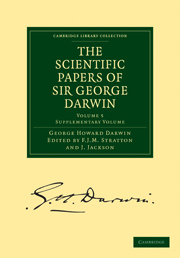
-
Select format
-
- Publisher:
- Cambridge University Press
- Publication date:
- June 2011
- July 2009
- ISBN:
- 9780511703515
- 9781108004480
- Dimensions:
- Weight & Pages:
- Dimensions:
- (244 x 170 mm)
- Weight & Pages:
- 0.23kg, 148 Pages
You may already have access via personal or institutional login
Book description
Sir George Darwin (1845–1912) was the second son of Charles Darwin. After studying mathematics at Cambridge he read for the Bar, but soon returned to science and to Cambridge, where in 1883 he was appointed Plumian Professor of Astronomy and Experimental Philosophy. His work was concerned primarily with the effect of the sun and moon on tidal forces on Earth, and with the theoretical cosmogony which evolved from practical observation: he formulated the fission theory of the formation of the moon (that the moon was formed from still-molten matter pulled away from the Earth by solar tides). He also developed a theory of evolution for the Sun–Earth–Moon system based on mathematical analysis in geophysical theory. This volume, published in 1916 after the author's death, includes a biographical memoir by his brother Sir Francis Darwin, his inaugural lecture and his lectures on George W. Hill's lunar theory.
Contents
Metrics
Full text views
Full text views help Loading metrics...
Loading metrics...
* Views captured on Cambridge Core between #date#. This data will be updated every 24 hours.
Usage data cannot currently be displayed.
Accessibility standard: Unknown
Why this information is here
This section outlines the accessibility features of this content - including support for screen readers, full keyboard navigation and high-contrast display options. This may not be relevant for you.
Accessibility Information
Accessibility compliance for the PDF of this book is currently unknown and may be updated in the future.


